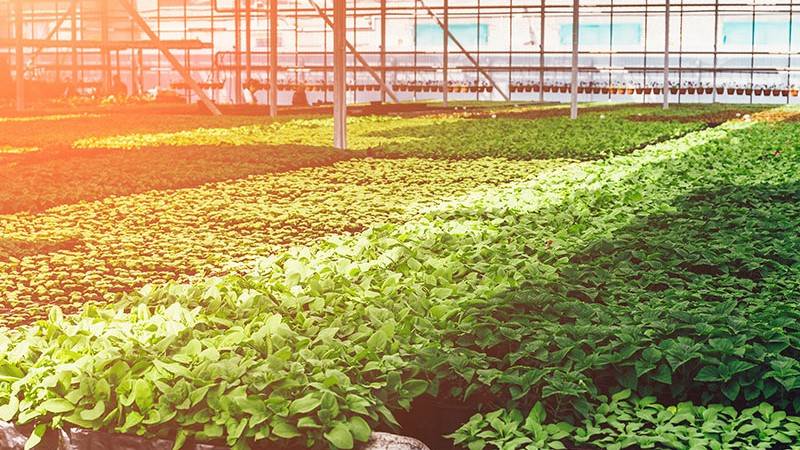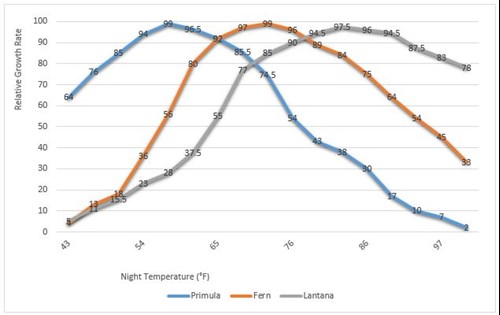Temperature Requirements for Greenhouse Crops


Temperature is the single greatest environmental input regulating plant growth, which is then closely followed by light intensity. This article will focus on the impact of temperature on plant growth.
How Is the Optimum Temperature Calculated?
The rate of plant growth is dictated by the average daily temperature. This is calculated by adding the average day temperature multiplied by the number of daylight hours to the average night temperature multiplied by the number of hours of darkness, and dividing that total by 24. Every crop has a base minimum temperature, at which it will grow at the maximum pace for its optimal temperature.
The optimum temperature produces crops in the shortest length of time, but seldom does it produce the most desirable plants. Determining the ideal average daily temperature for maximum plant growth and quality is the main goal of professional growers, but it will vary depending on the crop grown.

If, for example, all plants were grown at 55°F (13°C), at night, it would be ideal for primula, but the growth rate of ferns and lantana would be much slower. One temperature is not ideal for all crops.

Temperature Growing Guide for Annuals and Perennials
Greenhouse crops can be broken down into three basic categories: Cool season crops, those with a base temperature below 39°F (4°C), intermediate crops, those with a base temperature between 40-45°F (4-7°C), and warm season crops, those with a base temperature of 46°F (8°C) or higher (See table below for crops listed in each category).
The base temperature is the temperature at or below which plant growth ceases. Ideally, a grower should keep cool-season crops and warm-season crops in separate greenhouses so that each can be grown at their ideal temperature.
| Season (Cold Sensitive) 46 °F (8 °C) or higher |
Intermediate 40-45 °F (4-7 °C) |
Cool Season (Cold Tolerant) 39 °F (4 °C) or lower |
|---|---|---|
| Angelonia | Calibrachoa | Ageratum |
| Begonia | Coreopsis | Alyssum |
| Celosia | Dahlia | Cineraria |
| Gazania | Impatiens | Easter, Asiatic Lily |
| Hibiscus | Red Salvia | Gaillardia |
| New Guinea Impatiens | Nemesia | |
| Pepper | Pansy | |
| Poinsettia | Petunia | |
| Vinca | Snapdragon |
There are two primary factors a grower must consider when determining the ideal temperature to produce crops in relation to maximizing profits. First, what date does the crop need to be ready for market? Second, what level of crop quality does the grower intend to produce?
Scheduling Greenhouse Crops
Crop finish time is faster in warmer growing environments than in cooler environments. A grower must work backward from the plant shipping date to determine the planting date and look at greenhouse heating costs vs. additional overhead costs associated with planting earlier.
By planting earlier in the season, a grower can potentially save heating costs by lowering the average daily temperature if the increased time of heating does not outweigh the savings of reduced temperatures.
It is important to include additional start-up expenses, such as electric, labor, and overhead costs when determining if it is economical to open your greenhouses earlier in the spring season.
Additionally, cooler greenhouse temperatures can result in increased potential for root rot diseases and the associated costs of fungicide applications.
Reducing Heating Cost in Greenhouse
Since the average daily temperature dictates growth rate, a grower can maximize average temperature while reducing fuel costs by managing the daytime temperature set points for airflow and ventilation.
Even in cold northern climates, a sunny day produces the “greenhouse effect” in which the internal temperature rises rapidly, and then the fans turn on and vents open. By increasing the temperature set points, crops can be grown at much warmer temperatures during a sunny day and lower night temperatures; therefore, the same average daily temperature is maintained. This reduces heating costs.
| Average 8-hour day temperatures | Average 16-hour night temperatures |
|---|---|
| 72 °F (22 °C) | 66 °F (19 °C) |
| 80 °F (27 °C) | 62 °F (17 °C) |
| 90 °F (32 °C) | 57 °F (14 °C) |
The above shows the day and night temperatures required to produce the same average daily temperature of 68°F (20°C). Notice that growing at warmer day temperatures allows to grow at colder night temperatures while achieving the same average daily temperature.
Get our tips for efficient energy conservation in a Greenhouse.
Advantages of Growing at Lower Temperatures
The costs associated with heating and opening the greenhouses earlier should not be the only factors considered when determining the ideal temperature for greenhouse production.
Plants grown at lower temperatures grow slower and take longer to flower but often have thicker stems, better branching and larger flowers when they reach maturity. This higher quality crop can translate into a higher selling price for the grower which can offset the increases in production costs.
Growers must look at their specific market to determine if it can support extended crop finishing time and additional production costs for a higher-quality crop.
What is Better: Higher or Cooler?
An additional factor that will dictate the production time is the plug size. Larger plugs cost more per plant but will reduce production time and allow a grower to meet shipping dates, without either opening the greenhouses earlier or increasing heating expenses.
Growing crops at a higher average temperature will decrease production time, but often results in softer plants. Growing plants at cooler temperatures takes longer but it often produces a higher quality crop.
There is no absolute recommendation for greenhouse temperature management. A grower must balance the costs of fuel, opening greenhouses earlier, and shortening the growing cycle, with the specific crop quality and demands of the market.